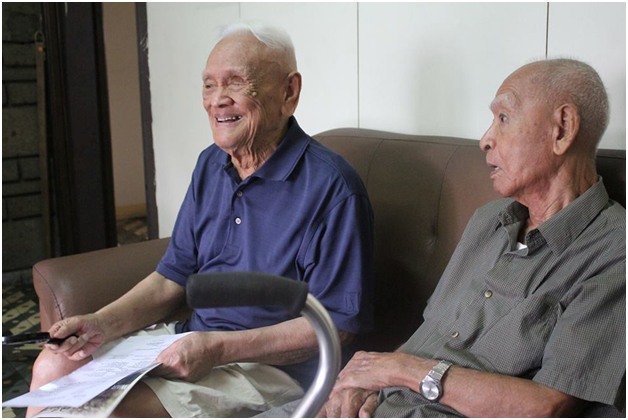
Of the estimated 80,000 Filipino and American prisoners of war who took part in the infamous Bataan Death March 76 years ago, only three are still alive.
Records at the Philippine Veterans Affairs Office named the centenarian war veterans as Private First Class Juliano de La Peña, 107, Colonel Catalino del Rosario Ibañez, and Colonel Vicente F Alhambra, 102.
Despite his age, de La Peña visited the PVAO on Thursday (April 5) to receive a commendation for his honourable service to the country during World War II and as survivor of the Bataan Death March.
Senator Panfilo Lacson, who was guest speaker during the ceremony in Camp Aguinaldo, handed the plaque to de La Peña, and to 64 other war veterans who received the same commendation.
Lacson was assisted by PVAO administrator, Lieutenant General Ernesto G Carolina (retired).
Alhambra and Ibañez received their plaques last year.
In the case of Alhambra, he held the distinction as a veteran of three wars – World War II, the Korean War and the Hukbalahap anti-insurgency campaign in Luzon.
Incidentally, this writer had the rare opportunity of interviewing Alahambra in his house in Cavite.
During the interview, Alhambra said his secret to longevity and how he survived against all odds, including the infamous “Bataan Death March”, unscathed was because “God was on his side” all throughout the ordeal where many had died of exhaustion or were shot dead or bayoneted by the Japanese.
“Remain active but most of all be prayerful,” Alhambra said.
It was in Bataan and Corregidor where Filipino and American soldiers made their last stand against the Japanese during the war, which lasted more than three months before they surrendered on April 9 and May 6, 1942, respectively.
Alhambra kept his photo albums of World War II, the Korean War in 1950-53, and the anti-insurgency drive against the Huks.
He said he prays to God for protection, which he confided is his secret weapon, especially during two wars and the fight against the Huks.
A graduate of the Philippine Military Academy class of 1942, Alhambra and all his classmates were automatically drafted into military service three months before graduation when World War II broke out following the bombing of the Philippines by Japanese planes on December 8, 1941.
He said the entire academy class of 1942, including Jose Crisol, who became defence undersecretary in post-war years, reported to then Armed Forces chief of staff General Mariano Castaneda for immediate deployment to fight the invading Japanese forces.
“We were the first PMA class called to active duty,” Alhambra recalled.
He said Japanese warplanes bombed Baguio and Cavite where US naval forces were stationed at Sangley Point.
Alhambra said he was enlisted into the 2nd Regular Division of the United States Armed Forces in the Far East assigned in Mariveles, Bataan.
It was in Bataan that the bulk of Filipino and American forces stood their ground to defend the Philippines until they were forced to surrender on April 9, 1942, due to a shortage of ammunition, food and medicines.
Alhambra vividly described the fall of Bataan as a “sad day” as he and his comrades-in-arms became prisoners of war of the Japanese forces.
He said he was lucky that he did not get sick during the Death March from Mariveles, Bataan to San Fernando, Pampanga and during his incarceration in Capas, Tarlac, which lasted for several months before he and other prisoners were freed.
“As many as 500 POWs died eveyday due to malaria in the concentration camp,” he said. “It was horrible!”
“While I was held a prisoner of war, a woman friend of mine gave me a mosquito net. The mosquito net was handed to a friend who, in turn, gave it to me inside my cell,” Alhambra related.
He also recalled the lack of food inside the concentration camp.
“We survived eating ‘tinapa’ if at all it was available,” Alhambra said. “We were lucky to eat once a day and that would suffice for our breakfast, lunch and dinner rolled into one.”
When liberation came, Alhambra found himself locked in battle, this time against the Huk insurgents in Central Luzon.
He survived anew but during the height of the insurgency campaign, Alhambra volunteered as a member of the 10th Battalion Combat Team of the Philippine Expedition Force to Korea (PEFTOK), together with then Second Lieutenant Fidel V Ramos, who later became the 12th President of the Philippines, and First Sergeant Maximo P Young, a be-medalled Filipino soldier during the Korean War.
“The Korean War was brutal,” Alhambra said. “But it was during the Korean War that proved again the bravery of the Filipino soldiers, who refused to back down against the wave by wave attacks by the enemy.”
The PEFTOK forces were highly trained in combat that of the 7,425 Filipino soldiers who fought in the Korean War, PEFTOK lost only 1,170 men.
Alhambra retired in 1967 as a colonel in the Philippine Constabulary.
Born on July 19, 1916, Alhambra will be 103 years old this July.
On the other hand, Colonel Ibañez is a licensed civil engineer and a lawyer. He is also known as the only PMA cadet who signed his own diploma and all the diplomas of his classmates because the PMA Class of 1942 went straight to war and had no graduation ceremonies.
It was only in 1948 that the Class of 1942 was ordered back to the PMA to attend their formal graduation exercises and received the long overdue diplomas.
But even in their twilight years, Col. Alhambra, and Col. Ibañez chat together to recall their individual stories of World War II wherein their comrades-in-arms, Filipinos and Americans displayed their heroism and sacrifices in defence of freedom and democracy.

Comments are closed.